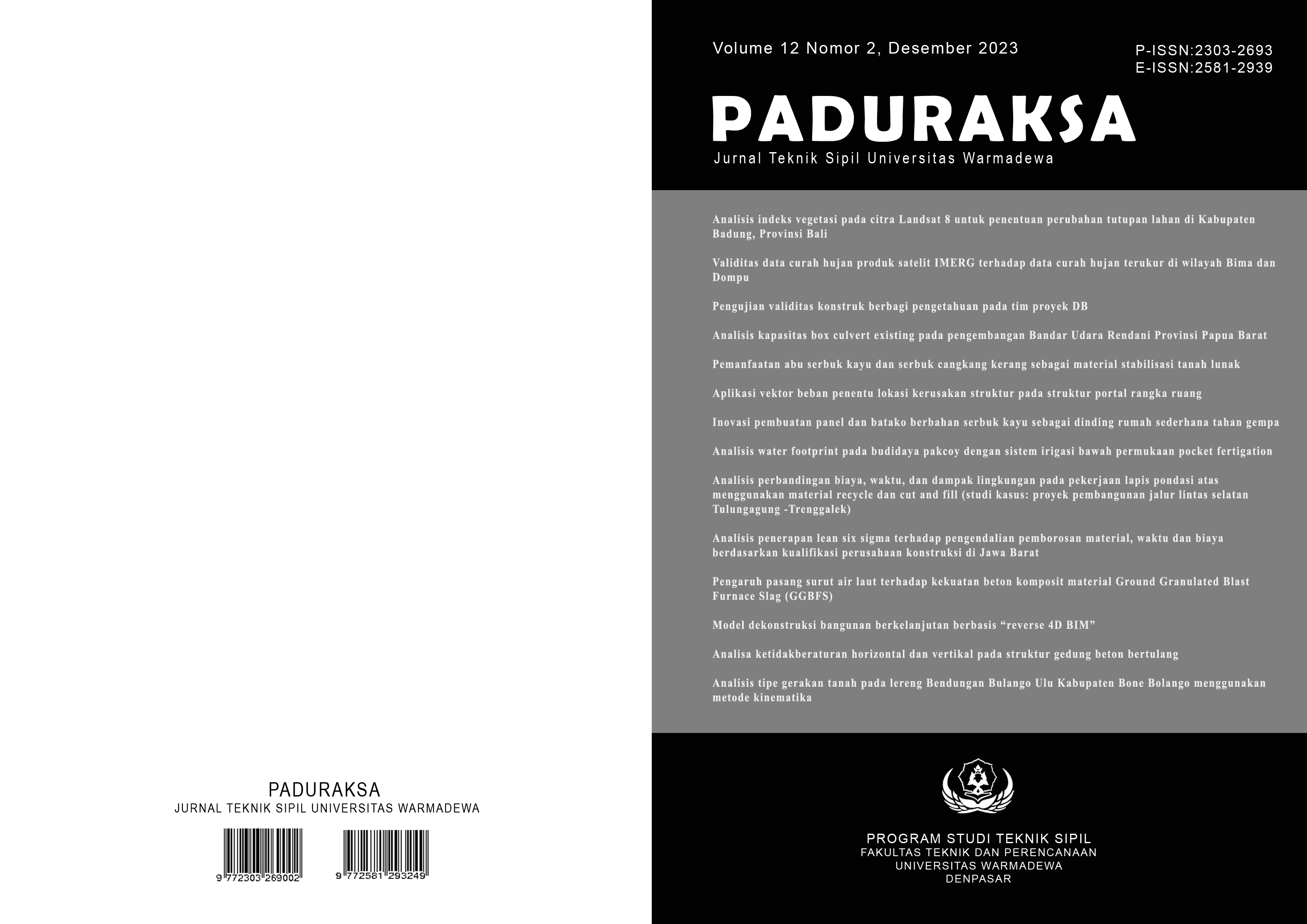Model dekonstruksi bangunan berkelanjutan berbasis “reverse 4D BIMâ€
Abstract
Indonesia's increasing population and limited land have made the need for shelter, workplaces, and vertical buildings increase. As a consequence, buildings that have exceeded their service life, have changed their function, have been damaged by a disaster, and are not fit for function need to be demolished. Demolition needs special attention because the process requires complex planning, is hidden, carries high risks, and generates more than 40% of the total solid waste in developing countries. In Indonesia in particular, deconstruction has not been carried out by many demolition service providers. The government does not yet have comprehensive regulations for sustainable building demolition. This study aims to propose a sustainable demolition model by prioritizing the conservation of demolition waste material. In this study, the "reverse 4D BIM" technology is used to visualize the sequencing of the demolition process and predict the type, volume, and scheduling of disposal of demolition waste. The predicted results of demolition waste are then classified for their use using reduce, reuse, and recycle (3R) concept to maximize the sustainability of the demolition process and the circular economy. To implement this model, a 4D BIM-based building simulation is used. The simulation results show that the proposed model is effective and can be implemented for sustainable building demolition.
References
Adi, T. J. W., & Wibowo, P. (2020). Application of Circular Economy in the Indonesia Construction Industry. IOP Conference Series: Materials Science and Engineering, 849(012049).
Ahmad, Z. B., & Anigbogu, N. A. (2010). Deconstruction: A Sustainable End to a Building. Nigerian Journal of Construction Technology and Management, 11(2), 63-69.
André, M. & João Poças M. (2018). A Survey on Modeling Guidelines for Quantity Takeoff Oriented BIM-Based Design. J. Automation in Construction, 35, 238-253.
Andriyani, N., Adi, T. J. W., Suprobo, P., Aspar, W. A. N., Rachmawati, F., & Pradono, M. H. (2023). AIP Conf. Proc. 2847, 040007. https://doi.org/10.1063/5.0165463
Anoop, S. & Bradford, R. H. (2011). Estimating With BIM: A Survey of US Construction Companies. Proceedings of the 28th ISARC, Seoul, Korea, 564-569.
Ashcraft, H. W. (2008). Building Information Modeling: A framework for collaboration. Construction Lawyer, 28.
Bazjanac, V. (2005). Model Based Cost And Energy Performance Estimation During Schematic Design. Lawrence Berkeley National Laboratory, University of California. Berkeley. USA.
Bilal, S. (2009). Building Information Modelling Framework: A Research and Delivery Foundation for Industry Stakeholders. J. Automation in Construction, 18(3), 357-375.
Environmental Protection Agency (2008). Lifecycle Construction Resource Guide. USA. ww.epa.gov/region4/p2.
Ghang, L., Rafael, S., & Charles, M. E. (2006). Specifying Parametric Building Object Behavior (BOB) for a Building Information Modeling System. J. Automation in Construction, 15(6), 758-776.
Guy, B. & Korber, A. (2006). Design for Disassembly in the Built Environment, Pennsylvania State University’s Hammer Center for Community Design and The Community Housing Resource Center. Lifecycle Construction Resource Guide. Environmental Protection Agency
Guy, B. (2006). The Optimization of Building Deconstruction for Department of Defense Facilities: Ft. McClellan Deconstruction Project. International Journal of Environmental Technology and Management, 6(3/4), 386-404.
Kanters, J. (2018). Design for Deconstruction in the Design Process: State of the Art. Buildings, 8(150).
Kementerian PUPR. (2018). Pembangunan Bangunan Gedung Negara. Permen PUPR No.22.
Kementerian LH. (2010). Peraturan Menteri Negara Lingkungan Hidup No. 8.
Khosakitchalert, C., Yabuki, N., & Fukuda, T. (2019). Improving the Accuracy of BIM-Based Quantity Takeoff for Compound Elements. J. Automation in Construction, 106.
Khosakitchalert, C., Yabuki, N., & Fukuda, T. (2019). Automatic Concrete Formwork Quantity Takeoff Using Building Information Modeling. In Proceedings of the 19th International Conference on Construction Applications of Virtual Reality (CONVR), 21–28.
Ma, Z., & Liu, Z. (2014). BIM-Based Intelligent Acquisition of Construction Information for Cost Estimation of Building Project. Procedia Engineering, 85, 358-367.
Monteiro, A., & Martins, J. (2013). A Survey on Modeling Guidelines for Quantity Takeoff-Oriented BIM-Based Design. J. Automation in Construction, 35, 238–253.
Olsen, D., & Taylor, J. M. (2017). Quantity Take-Off Using Building Information Modeling (BIM), and Its Limiting Factors. Procedia Engineering, 196, 1098–1105.
Ruchini, S.J., Raufdeen R., & Nicholas C. (2019). Exploring Sustainable Post-End-Of-Life of Building Operations. J. Engineering, Construction and Architectural Management. 26(4), 689-722.
Sabol, L. (2008). Challenges in Cost Estimating with Building Information Modeling. Design and Construction Strategies. Retrieved 8th December 2010, 1-16.
Sacks, R., Eastman, C. M., & Lee, G. (2004). Parametric 3D Modeling in Building Construction with Examples from Precast Concrete. J. Automation in Construction, 13(3), 291-312.
Shen, Z., & Issa, R. R. A. (2010). Quantitative Evaluation of the BIM-Assisted Construction Detailed Cost Estimates. J. Information Technology in Construction, 15, 234–257.
Sopaheluwakan, M. P., & Adi, T. J. W. (2020). Adoption and Implementation of Building Information Modeling (BIM) by the Government in the Indonesian Construction Industry. IOP Conference Series Materials Science and Engineering. 4th International Conference on Civil Engineering Research. Surabaya, 22-23 July 2020, 930.
Authors who publish with this journal agree to the following terms:
- Authors retain copyright and grant the journal right of first publication with the work simultaneously licensed under a Creative Commons Attribution License that allows others to share the work with an acknowledgement of the work's authorship and initial publication in this journal.
- Authors are able to enter into separate, additional contractual arrangements for the non-exclusive distribution of the journal's published version of the work (e.g., post it to an institutional repository or publish it in a book), with an acknowledgement of its initial publication in this journal.
- Authors are permitted and encouraged to post their work online (e.g., in institutional repositories or on their website) prior to and during the submission process, as it can lead to productive exchanges, as well as earlier and greater citation of published work (See The Effect of Open Access).
 Abstract viewed = 130 times
Abstract viewed = 130 times
 PDF downloaded = 134 times
PDF downloaded = 134 times










